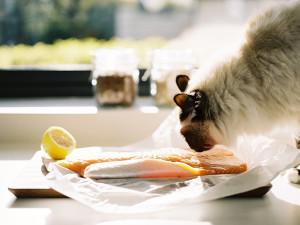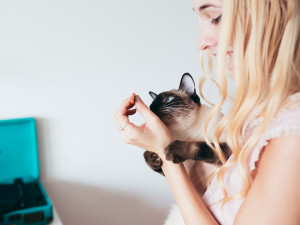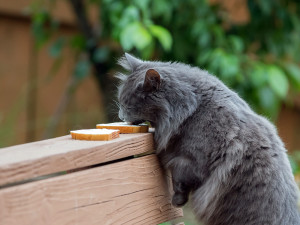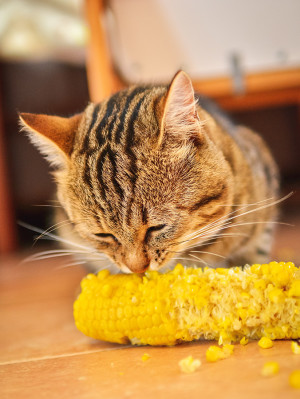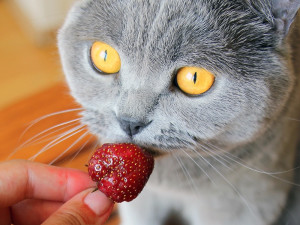Can Cats Eat Tomatoes?
A little tomato’s safe — with some important caveats.
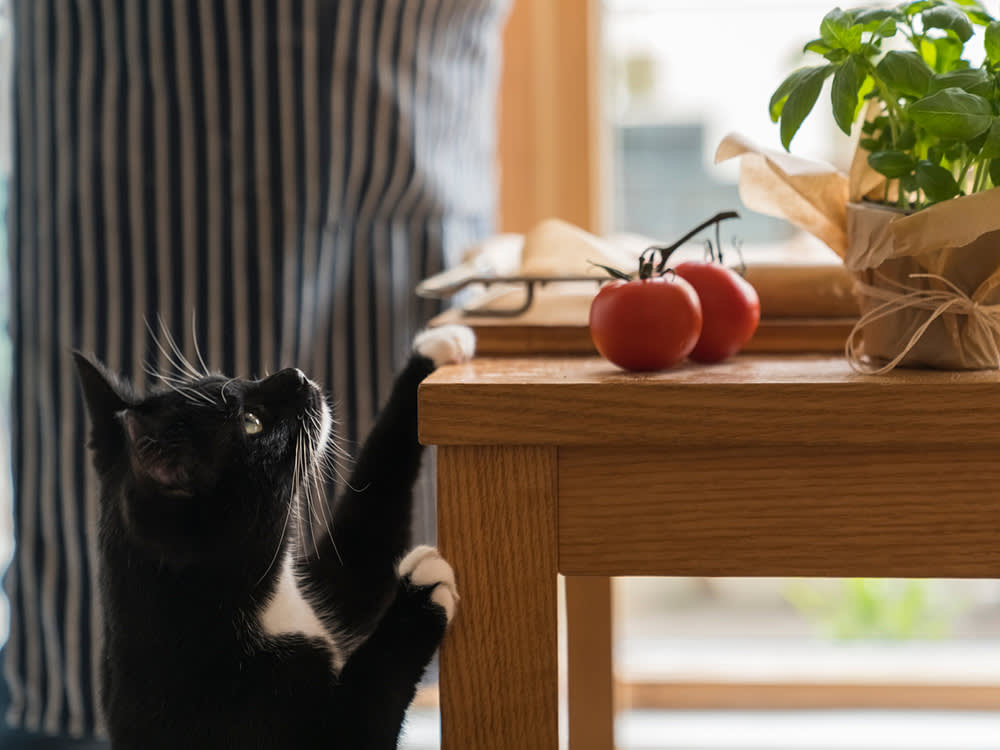
Share Article
Cats, like people, have their own unique taste preferences — and while some cats are incredibly picky about what they’ll sink their teeth into, others seem to be willing to try almost anything. If you have an adventurous eater, you may be wondering what foods are safe for your cat to sample, and which ones should be avoided.
Tomatoes fall into the safe category as long as only the ripe fruit is offered and it is shared in small portions. While many cats may be turned off by the squishy, juicy texture of the tomato fruit, there are always those outliers who get a thrill out of batting around the small round fruits and feeling the pop of a ripe tomato. Read on to learn more about sharing tomatoes with your cat.
Nutrition facts about tomatoes for cats
Tomatoes are a classic superfood given all of their amazing health benefits, but not everyone agrees on whether or not raw tomatoes are delicious or have a certain yuck factor. Cats are likely to be similarly divided; the texture of the raw tomato fruit coupled with the burst of juice and seeds can be a big turn off for many people and likely many cats. For those who enjoy the experience, the health benefits are maximized when eating tomatoes raw. The good news is that even cooked tomatoes provide many health benefits, so it may be time to rebrand pizza as a health food.
Some of the valuable nutrients in tomatoes include fiber, antioxidants, and vitamins and minerals. Tomatoes also have a large water content, which is good for hydration and makes them filling without adding a lot of calories to the diet. They are very low in fat and protein, which are crucial in a cat’s diet; they are obligate carnivores. So, it is very important to make sure your cat is not filling up on foods like this in place of more protein-dense foods that they really need. For these reasons, tomatoes can be a fun addition to your cat’s snack options, as long as they eat a complete and balanced cat food to provide them with the bulk of their nutritional needs.

Are tomatoes good for cats?
Tomatoes can provide some healthy nutrients to cats and are sometimes included in commercial cat food diets for their beneficial properties. They lack many important nutrients that cats need for survival, however, and should only be offered in small amounts. Here are some of the perks of including tomatoes in your cat’s diet:
Fiber: Tomatoes contain mostly insoluble fiber, especially in the skin and seeds of the fruit that can help add bulk to the stool, preventing constipation, and keeping things regular. This can also help cats feel satisfied on a lower-calorie diet if they need to lose weight. Tomatoes also have smaller amounts of soluble fiber, which serves as an important source of nutrients for the good microbes in the gut. Some commercial cat foods will use tomato pomade as a fiber source for these reasons.
Vitamin C: While we hear so much about the health benefits of foods loaded with vitamin C, this one really doesn’t matter to cats. Cats can actually make their own vitamin C and do not need to get it from their diets, as opposed to humans. Too much vitamin C can also be harmful to cats because it can put them at risk for bladder stones.
Lycopene: Tomatoes are often celebrated for their lycopene content, a potent antioxidant that can prevent cell damage from free radicals. While cats do not have a specific nutritional requirement for lycopene, they may benefit from a boost of antioxidants, which can have wide ranging benefits against cancer, heart disease, and aging.
Potassium: Potassium is a mineral used in basic cell functions throughout the body, and is especially important for normal muscle, heart, and nerve function. Tomatoes are rich in potassium.
Water content: Tomatoes contain a large volume of water, like many fruits and vegetables. This can be both a pro and a con for cats. Cats are not usually enthusiastic water drinkers and cats with certain medical conditions may benefit from upping their water intake. If you have a tomato-loving cat, this can be a great way to keep them hydrated. On the other hand, filling up on watery foods like tomatoes can take up valuable real estate in a cat’s tiny stomach. If they don’t eat their balanced cat food diet because they are full from snacking, this can interfere with their nutritional needs. In the long-term, this can can put them at risk for nutritional deficiencies.
Can cats eat any part of the tomato?
Cats can only eat ripe tomato fruit. The tomato plant, including stems, leaves, and green unripe fruits are considered toxic. These parts of the tomato plant contain a glycoalkaloid compound called tomatine and may also contain another called solanine. These are considered toxic and are found in many plants of the nightshade family, including potatoes and eggplant. As the tomato fruit ripens, levels of these compounds drop to a negligible amount and therefore the ripe fruit is considered safe to eat in moderation.
Signs of toxicity from ingesting tomatine include drooling, vomiting, diarrhea, loss of appetite, and lethargy. In the majority of cases, cats do not consume enough of the plant matter to have serious or fatal effects and most will experience self-limiting digestive upset such as vomiting and diarrhea. It’s best to have your cat examined by a vet if you believe they have ingested any of these parts of the tomato plant, however, as the concentrations of these toxins can vary greatly from one plant species to another.
Is tomato completely safe for cats?
It is important to keep in mind a few things when offering tomatoes to cats to ensure their safety. First, be sure the tomatoes are ripe and that you keep tomato plants out of reach to avoid any risks of tomatine toxicity. Next, make sure what you are offering is in a form that is suitable for your cat by avoiding the following:
Choking hazards: When offering your cat any treat or table scrap, be sure to offer it in a bite-sized portion that will be easy to chew and swallow. Whole cherry tomatoes or large chunks of tomato can be a choking hazard and can also be difficult to digest. Try to remove large pieces of skin that may be tougher to chew and swallow.
Other ingredients: This is a good reminder that other ingredients we cook with and/or eat may be toxic to cats. If you are feeding your cat a cooked dish containing tomatoes, including tomato-based sauces, double-check that the other ingredients are safe and nontoxic as well. Avoid feeding your cat anything that may have been cooked with garlic, onions, lots of salt, spicy peppers, or other ingredients that could be unhealthy for your cat.
The bottom line: Can cats eat human food?
Cats can eat certain human foods, and they often love a lot of the same foods as we do. Sharing a snack with your cat is a fun bonding activity and also enriches your cat’s life by exposing them to different flavors, textures, and novel experiences. As long as you do your research to make sure the food you are providing is safe and non-toxic to cats, you will find many foods that you can share with your cat. Always start with a very small amount of the new food and be sure to monitor your cat for any signs of adverse reactions, such as gagging, vomiting, diarrhea, and/or swelling of the face.
Also, make sure that your cat’s primary diet is a complete and balanced cat food diet. Snacks and treats should be kept to less than 10 percent of your cat’s total intake to ensure they eat enough of their primary diet to get all of the unique nutrients they really need. This is especially important with fruits and vegetables that have a high water content, such as tomatoes. All of that water fills them up without providing them with the sustenance they really need. There are also many human foods that are unfortunately toxic to cats, so be sure to consult your veterinarian or a pet poison hotline if you have any questions about what foods are safe for cats.
Other human foods that are safe for cats
Blueberries can be a tasty snack to share with your cat in moderation
Peanut butter can also be a special treat as long as you watch out for added sodium and sugar
Corn is also OK in small amounts
Other human foods that are dangerous for cats
Garlic can cause a life-threatening anemia in cats
Grapes and raisins should be avoided, too
Cheese can be risky to share with your cat, so be sure to do your research
FAQs (People also ask)
Can cats eat tomatoes?
Cats can eat ripe tomatoes in moderation. Avoid giving cats unripe tomatoes and any parts of the tomato plant; these contain toxic compounds.
How much tomato can a cat eat?
Tomatoes can be given as a small treat to cats. In general, treats should be less than 10 percent of a cat’s total diet.
Is tomato safe for cats?
Ripe tomatoes are safe for cats; however, unripe tomatoes and parts of the tomato plant contain toxins that can make cats sick.
Is it OK to give cats tomatoes?
It’s OK to give cats small snacks of tomatoes as long as the bulk of their diet is a complete and balanced cat food diet.
Why do cats like tomatoes?
Cats may be intrigued by chasing rolling tomatoes and they may also like the texture of the fruit. Other cats may not be interested in tomatoes at all due to their taste, smell, or burst of juice inside of them.
Can cats eat tomato plants?
Tomato plants are considered toxic to cats due to a compound called tomatine. They should not eat the leaves, stems, flowers, or unripe fruits for this reason.
References:

Dr. Amy Fox, DVM
Amy Fox, DVM is a small animal veterinarian in New York City with over thirteen years of experience in a mixture of general practice, emergency medicine, and shelter medicine. A lifelong animal lover, Dr. Fox studied biology in college and then worked as a veterinary nurse before pursuing veterinary school at Cornell University. Her expertise includes surgery, dentistry, and management of chronic conditions, and she is interested in toxicology, pain management, nutrition, care of senior pets, and educational outreach. Dr. Fox also enjoys writing about veterinary medicine and teaching, and her work has previously appeared in Spruce Pets. In her free time, she loves to cook, garden, go for long runs, and hang out with her goofy mixed-breed dog May, who provides never ending comic relief!
Related articles
![an orange and brown cat nibbles corn on the cob]()
Can Cats Eat Corn?
A few kernels won’t hurt, but think twice before doling out a bowl of the stuff.
![Woman with tattoos eating noodles on the couch with her cat]()
Can Cats Eat Garlic?
It’s a human cooking staple, but your cat shouldn’t indulge.
![Grey cat eats a strawberry]()
Can Cats Eat Strawberries
Yes, strawberries are a nutritious treat for dogs.
![Cat behind a curtain attempting to get fruit in blue bowl]()
What Fruits and Veggies Can Your Cat Feast On?
Pass the fruit bowl — it’s treat time.
![A curious kitty playing with a vase of tulips.]()
Are Tulips Toxic to My Cat?
These flowers are cheerful, but you need to keep them far away from your kitty.
Can Cats Eat Popcorn?
They want to enjoy movie night, too, you know.

